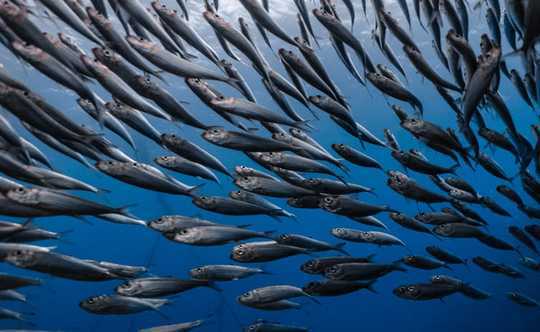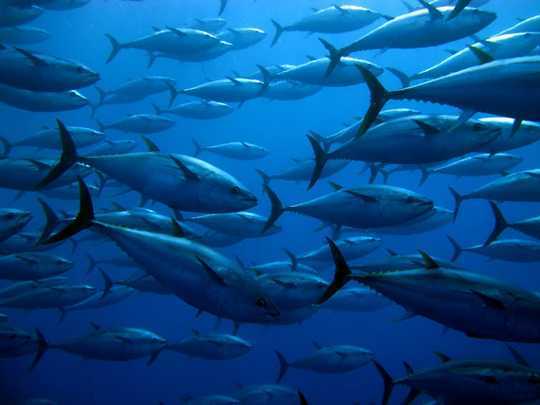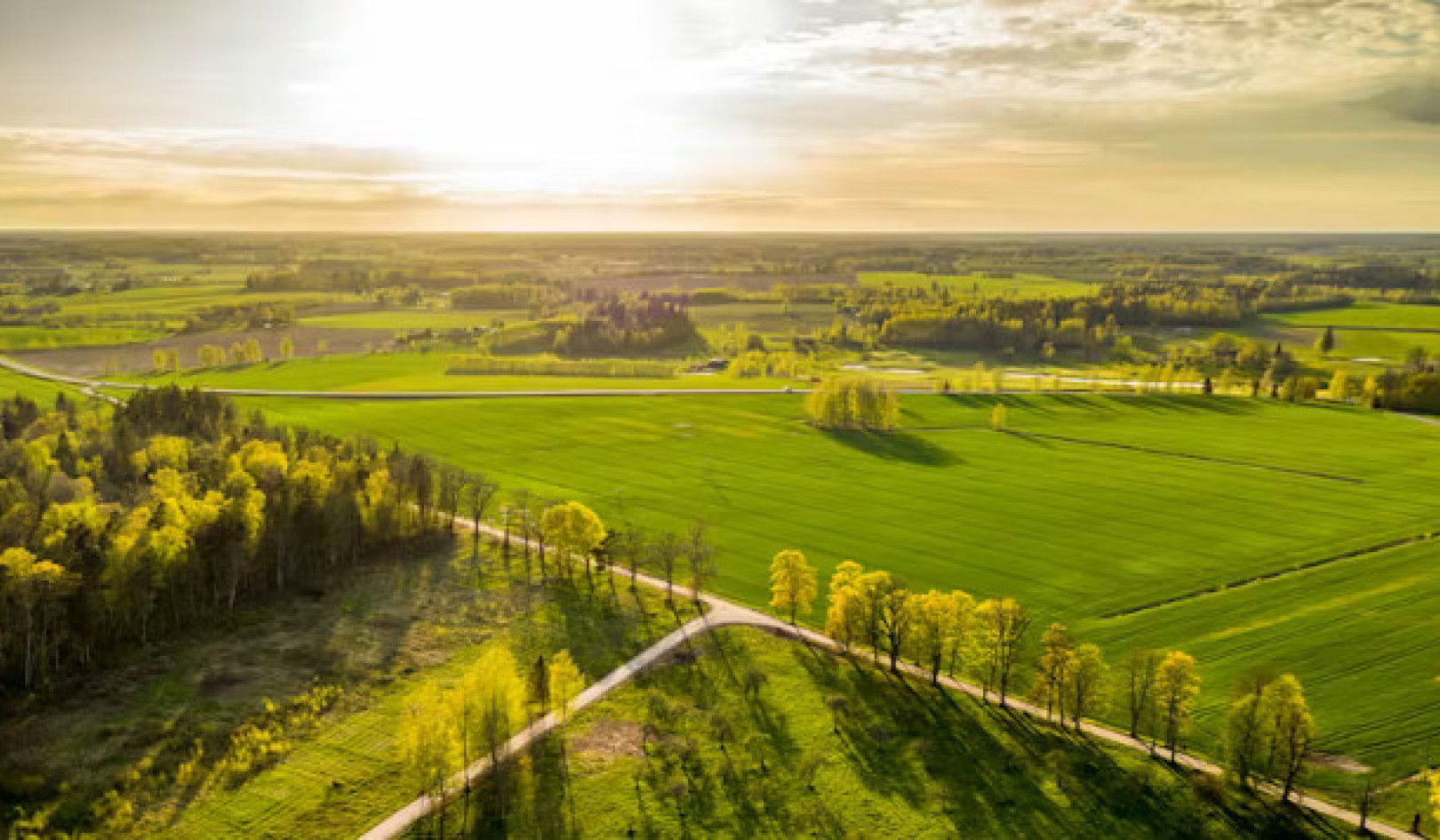
Mercury levels in Pacific sardines could rise by as much as 14 per cent if greenhouse gas emissions continue to rise. (Shutterstock) Juan Jose Alava, University of British Columbia
We live in an era — the Anthropocene — where humans and societies are reshaping and changing ecosystems. Pollution, human-made climate change and overfishing have all altered marine life and ocean food webs.
Increasing ocean temperatures are amplifying the accumulation of neurotoxic contaminants such as organic mercury (methylmercury) in some marine life. This especially affects top predators including marine mammals such as fish-eating killer whales that strongly rely on large fish as seafood for energy.
Now the combination of mercury pollution, climate change and overfishing are conspiring together to further contaminate marine life and food webs. This has obvious implications for ecosystems and the ocean, but also for public health. The risk of consuming mercury-contaminated fish and seafood is growing with climate change.
Mercury rising
Regulations have lowered global mercury emissions from human-made sources, such as coal-fired power plants, between 1990 and 2010 but mercury is still present in the marine environment.
Methylmercury builds up in the muscle tissue of fish across the food web, “bioaccumulating” in larger and high trophic level predators. This is why larger pelagic fish (for example, tuna, marlins, billfishes and sharks) — those that eat a lot of fish — are in general considered riskier to eat than smaller ones.
In humans, mercury can lead to neurological disorders. Children who are exposed to mercury during fetal development and childhood have a greater risk of poor performance on tests that measure attention, IQ, fine motor function and language.
Climate change can amplify the accumulation of methylmercury in fish and marine mammals at the top of their food webs due to changes in the entry and fate of mercury in the ocean and the composition and structure of these marine food webs. A warmer and more acidic ocean may increase the amount of methylmercury that enters the food web.
Overfishing can also exacerbate the mercury levels in some fish species. Pacific salmon, squid and forage fish, as well as Atlantic bluefin tuna and Atlantic cod and other fish species are susceptible to increases in methylmercury due to rising ocean temperatures.
Our modelling research work shows that Chinook salmon, the largest Pacific salmon species and main prey of endangered southern resident killer whales, is projected to be exposed to high methylmercury accumulation due to changes in its prey that are driven by climate change.

Rising ocean temperatures leave some fish, including tuna, susceptible to increases in methylmercury. (Shutterstock)
Under a worst-case climate-change scenario, where greenhouse gas emissions continue to increase and global temperatures reach between 2.6C and 4.8C by 2100, Chinook salmon will see a 10 per cent increase in methylmercury. But under a best-case scenario, where emissions are low and global temperature rise is in the order of 0.3C to 1.7C at the end of the century, mercury levels would increase by only one per cent.
For forage fish, such as Pacific sardine, anchovy and Pacific herring, which are key ecological and commercial species in the Pacific Rim ecosystem, the methylmercury increase is projected to be 14 per cent under the influence of high emissions and three per cent under low emissions. Here again, this increase is driven by dietary shifts and changes in the food web composition due to warmer oceans.
Fishing down the food web
Atlantic cod stocks were over-exploited along the northeastern coast of Canada during the last century. Chinook salmon stocks from the northeastern Pacific Ocean are also dwindling because of natural factors and environmental stressors, including predation, habitat loss, warming oceans and fishing. The combination of these pressures can make Pacific salmon more susceptible to methylmercury bioaccumulation.
When one species is overfished, fishing fleets expand and adjust their targets, often fishing down the marine food webs. The cascading effects lead to changes in prey and foodweb composition for the remaining species, likely altering the transfer of organic contaminants such as persistent organic pollutants and methylmercury in top predators.
When fish are removed from the food web, larger fish and top predators may be forced to consume more or different prey, or smaller fish than they usually do. These fish can be highly contaminated with mercury.
The combination of climate change and overfishing are further shifting the composition of fish in the ocean and where they are found. They are also altering the way these species are exposed to pollutants, increasing levels of methylmercury in Atlantic cod and Atlantic blue fin tuna — fish that are often eaten by humans.
Protecting health and the planet
Based on this evidence, the public health community should revisit and revise fish consumption guidelines for those who are most likely to be exposed to mercury (coastal communities) or experience negative effects (pregnant women, infants and children).
Our simulations show that the projected methylmercury concentrations in forage fish and Chinook salmon will surpass Canada’s mercury consumption limits this century, as well as the consumption advisory level issued by the World Health Organization.
In our human-dominated world, it is imperative that we consume fish and shellfish that come from sustainable fisheries and make efforts to reduce ocean pollution. International and national environmental policies, such as the UN Sustainable Development Goal to conserve and sustainably use the oceans, marine resources and fisheries (SDG 14) and the Paris Climate Agreement, can conserve marine species and protect our blue planet for generations to come.
About The Author
Juan Jose Alava, Research Associate (Ocean Litter Project)/ Principal Investigator (Ocean Pollution Research Unit), University of British Columbia
This article is republished from The Conversation under a Creative Commons license. Read the original article.
Related Books
Life After Carbon: The Next Global Transformation of Cities
by Peter Plastrik , John Cleveland The future of our cities is not what it used to be. The modern-city model that took hold globally in the twentieth century has outlived its usefulness. It cannot solve the problems it helped to create—especially global warming. Fortunately, a new model for urban development is emerging in cities to aggressively tackle the realities of climate change. It transforms the way cities design and use physical space, generate economic wealth, consume and dispose of resources, exploit and sustain the natural ecosystems, and prepare for the future. Available On Amazon
The future of our cities is not what it used to be. The modern-city model that took hold globally in the twentieth century has outlived its usefulness. It cannot solve the problems it helped to create—especially global warming. Fortunately, a new model for urban development is emerging in cities to aggressively tackle the realities of climate change. It transforms the way cities design and use physical space, generate economic wealth, consume and dispose of resources, exploit and sustain the natural ecosystems, and prepare for the future. Available On Amazon
The Sixth Extinction: An Unnatural History
by Elizabeth Kolbert Over the last half-billion years, there have been Five mass extinctions, when the diversity of life on earth suddenly and dramatically contracted. Scientists around the world are currently monitoring the sixth extinction, predicted to be the most devastating extinction event since the asteroid impact that wiped out the dinosaurs. This time around, the cataclysm is us. In prose that is at once frank, entertaining, and deeply informed, New Yorker writer Elizabeth Kolbert tells us why and how human beings have altered life on the planet in a way no species has before. Interweaving research in half a dozen disciplines, descriptions of the fascinating species that have already been lost, and the history of extinction as a concept, Kolbert provides a moving and comprehensive account of the disappearances occurring before our very eyes. She shows that the sixth extinction is likely to be mankind's most lasting legacy, compelling us to rethink the fundamental question of what it means to be human. Available On Amazon
Over the last half-billion years, there have been Five mass extinctions, when the diversity of life on earth suddenly and dramatically contracted. Scientists around the world are currently monitoring the sixth extinction, predicted to be the most devastating extinction event since the asteroid impact that wiped out the dinosaurs. This time around, the cataclysm is us. In prose that is at once frank, entertaining, and deeply informed, New Yorker writer Elizabeth Kolbert tells us why and how human beings have altered life on the planet in a way no species has before. Interweaving research in half a dozen disciplines, descriptions of the fascinating species that have already been lost, and the history of extinction as a concept, Kolbert provides a moving and comprehensive account of the disappearances occurring before our very eyes. She shows that the sixth extinction is likely to be mankind's most lasting legacy, compelling us to rethink the fundamental question of what it means to be human. Available On Amazon
Climate Wars: The Fight for Survival as the World Overheats
by Gwynne Dyer Waves of climate refugees. Dozens of failed states. All-out war. From one of the world’s great geopolitical analysts comes a terrifying glimpse of the strategic realities of the near future, when climate change drives the world’s powers towards the cut-throat politics of survival. Prescient and unflinching, Climate Wars will be one of the most important books of the coming years. Read it and find out what we’re heading for. Available On Amazon
Waves of climate refugees. Dozens of failed states. All-out war. From one of the world’s great geopolitical analysts comes a terrifying glimpse of the strategic realities of the near future, when climate change drives the world’s powers towards the cut-throat politics of survival. Prescient and unflinching, Climate Wars will be one of the most important books of the coming years. Read it and find out what we’re heading for. Available On Amazon
From The Publisher:
Purchases on Amazon go to defray the cost of bringing you InnerSelf.comelf.com, MightyNatural.com, and ClimateImpactNews.com at no cost and without advertisers that track your browsing habits. Even if you click on a link but don't buy these selected products, anything else you buy in that same visit on Amazon pays us a small commission. There is no additional cost to you, so please contribute to the effort. You can also use this link to use to Amazon at any time so you can help support our efforts.

























